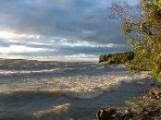Native group joins in fight against $1B development
Residents fighting a $1 billion marina and vacation resort on the western shores of Lake Simcoe have found a new ally in the Huron-Wendat Nation and the Chiefs of Ontario.
The groups found themselves on the same side of the table yesterday at the beginning of what was supposed to have been a four-month Ontario Municipal Board hearing into the controversial development on Big Bay Point, on the northeastern tip of Innisfil.
Instead, Tim Gilbert, lawyer for both the opposed residents and the Huron-Wendat, filed a motion to have the hearing adjourned on several grounds, including a claim that the First Nations group was never notified or consulted about the proposal until last month.
The project, on a 242-hectare property 10 kilometres east of Barrie, would feature 1,600 fractionally owned condos and townhomes, as well as 400 hotel rooms, a 1,000-slip boat marina and a golf course.
Its proposal five years ago provoked a nasty spat between developer Earl Rumm, of Geranium Corp., and some residents, cottagers and environmentalists who claim that a development that large – especially the marina – threatens an already fragile Lake Simcoe.
Opponents want the OMB hearings held off until after October's provincial election, because both the Tories and Liberals have said they will introduce legislation limiting development around the lake.
Premier Dalton McGuinty, however, has said his proposed protection act would not include Big Bay Point, which has the support of two residents' groups, the Town of Innisfil and Simcoe County.
"The First Nations affected by the development ... should have been consulted," Gilbert told the hearing yesterday in Alliston.
Documents filed at the hearing, he said, show that the 2004 discovery of pottery shards on the site by the developers' own archaeologist suggest the need for a detailed dig.
It is unclear which native group the artifacts belong to, but the Huron-Wendat claim there is a need to check for their mass burial sites because their ancestors lived in the area until 1648.
In a letter to Municipal Affairs and Housing Minister John Gerretsen, Quebec-based Max Gros-Louis, grand chief of the Huron-Wendat, said "our history of occupation of the north shore of Lake Ontario has been virtually wiped away by development." He said the Huron-Wendat still aren't being offered basic notification of such finds.
Huron-Wendat ossuaries, or mass burial sites, are scattered across south-central Ontario and have been found in recent times, including one near Jane St. and Teston Rd., where a York Region work crew discovered a site dating to 1450 with the remains of 400 people.
Gros-Louis said virtually every one of the hundreds of mass burial sites have "been dug up, the bones and sacred grave goods spirited away, sometimes to be stored in deplorable conditions."
"With this action (in Big Bay Point) we draw the line at Huronia," he wrote, saying his lawyers have filed a "notice of constitutional question" over the lack of notification with the attorneys general of Canada and Ontario.
Gilbert suggested that not allowing proper consultation with the Huron-Wendat is part of a pattern of "historic disregard" – a comment that prompted Jeffrey Davies, the developer's lawyer, to lash out at what he called grandstanding and a "soapbox sermon."
Davies said the constitutional notice should be quashed primarily because it was not filed within the requisite time period.
The residents, backed by groups such as Environmental Defence, also want the OMB hearings delayed on the grounds that lawsuits Rumm has filed against detractors – the head of a residents' group, local lawyers and cottagers – seeking $85.8 million in damages have created a climate of "intimidation."
Ontario Municipal Board vice-chair Jan Seaborn said she would allow a countermotion by Davies seeking to quash the native constitutional claims to be heard before hearing arguments about postponing the hearings.




0 Comments:
Post a Comment
<< Home